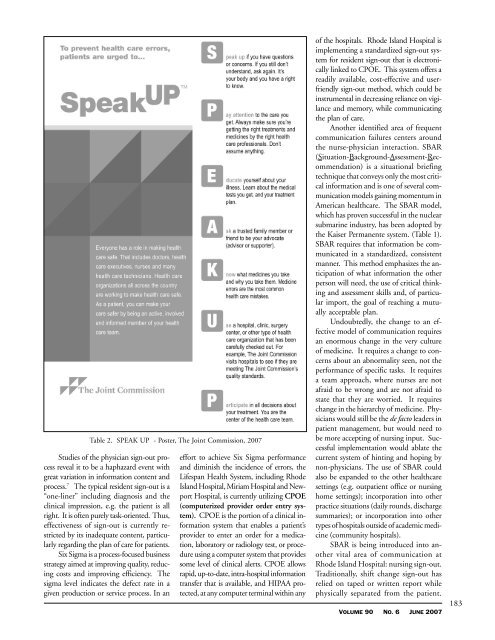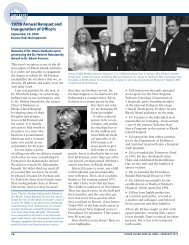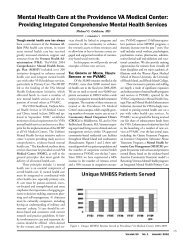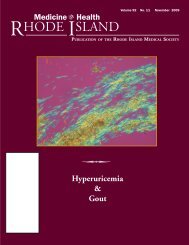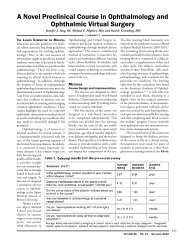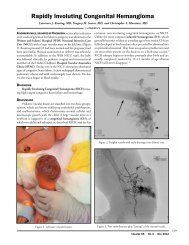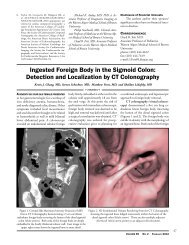June, No.6 - Rhode Island Medical Society
June, No.6 - Rhode Island Medical Society
June, No.6 - Rhode Island Medical Society
You also want an ePaper? Increase the reach of your titles
YUMPU automatically turns print PDFs into web optimized ePapers that Google loves.
Table 2. SPEAK UP - Poster, The Joint Commission, 2007Studies of the physician sign-out processreveal it to be a haphazard event withgreat variation in information content andprocess. 7 The typical resident sign-out is a“one-liner” including diagnosis and theclinical impression, e.g. the patient is allright. It is often purely task-oriented. Thus,effectiveness of sign-out is currently restrictedby its inadequate content, particularlyregarding the plan of care for patients.Six Sigma is a process-focused businessstrategy aimed at improving quality, reducingcosts and improving efficiency. Thesigma level indicates the defect rate in agiven production or service process. In aneffort to achieve Six Sigma performanceand diminish the incidence of errors, theLifespan Health System, including <strong>Rhode</strong><strong>Island</strong> Hospital, Miriam Hospital and NewportHospital, is currently utilizing CPOE(computerized provider order entry system).CPOE is the portion of a clinical informationsystem that enables a patient’sprovider to enter an order for a medication,laboratory or radiology test, or procedureusing a computer system that providessome level of clinical alerts. CPOE allowsrapid, up-to-date, intra-hospital informationtransfer that is available, and HIPAA protected,at any computer terminal within anyof the hospitals. <strong>Rhode</strong> <strong>Island</strong> Hospital isimplementing a standardized sign-out systemfor resident sign-out that is electronicallylinked to CPOE. This system offers areadily available, cost-effective and userfriendlysign-out method, which could beinstrumental in decreasing reliance on vigilanceand memory, while communicatingthe plan of care.Another identified area of frequentcommunication failures centers aroundthe nurse-physician interaction. SBAR(Situation-Background-Assessment-Recommendation)is a situational briefingtechnique that conveys only the most criticalinformation and is one of several communicationmodels gaining momentum inAmerican healthcare. The SBAR model,which has proven successful in the nuclearsubmarine industry, has been adopted bythe Kaiser Permanente system. (Table 1).SBAR requires that information be communicatedin a standardized, consistentmanner. This method emphasizes the anticipationof what information the otherperson will need, the use of critical thinkingand assessment skills and, of particularimport, the goal of reaching a mutuallyacceptable plan.Undoubtedly, the change to an effectivemodel of communication requiresan enormous change in the very cultureof medicine. It requires a change to concernsabout an abnormality seen, not theperformance of specific tasks. It requiresa team approach, where nurses are notafraid to be wrong and are not afraid tostate that they are worried. It requireschange in the hierarchy of medicine. Physicianswould still be the de facto leaders inpatient management, but would need tobe more accepting of nursing input. Successfulimplementation would ablate thecurrent system of hinting and hoping bynon-physicians. The use of SBAR couldalso be expanded to the other healthcaresettings (e.g. outpatient office or nursinghome settings); incorporation into otherpractice situations (daily rounds, dischargesummaries); or incorporation into othertypes of hospitals outside of academic medicine(community hospitals).SBAR is being introduced into anothervital area of communication at<strong>Rhode</strong> <strong>Island</strong> Hospital: nursing sign-out.Traditionally, shift change sign-out hasrelied on taped or written report whilephysically separated from the patient.VOLUME 90 NO. 6 JUNE 2007183


